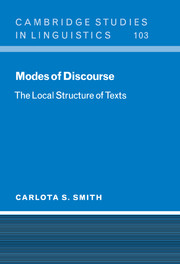Book contents
- Frontmatter
- Contents
- Preface
- Introduction
- PART I DISCOURSE STRUCTURE
- PART II LINGUISTIC ANALYSIS OF THE DISCOURSE MODES
- PART III SURFACE PRESENTATIONAL FACTORS
- PART IV DISCOURSE MODES AND THEIR CONTEXT
- 10 Information in text passages
- 11 Discourse structure and Discourse Modes
- Appendix A The Texts
- Appendix B Glossary
- References
- General index
- Index of names
10 - Information in text passages
Published online by Cambridge University Press: 18 June 2010
- Frontmatter
- Contents
- Preface
- Introduction
- PART I DISCOURSE STRUCTURE
- PART II LINGUISTIC ANALYSIS OF THE DISCOURSE MODES
- PART III SURFACE PRESENTATIONAL FACTORS
- PART IV DISCOURSE MODES AND THEIR CONTEXT
- 10 Information in text passages
- 11 Discourse structure and Discourse Modes
- Appendix A The Texts
- Appendix B Glossary
- References
- General index
- Index of names
Summary
This chapter brings together the main points of Discourse Mode, subjectivity, and presentational progression; and analyzes passages of text with the tools developed above. Section 10.1 gives the basic points of each area of analysis, with a reprise of the criteria for determining Primary Referents and sentence topics.
Section 10.2 analyzes text passages of the five Discourse Modes, according to temporality and types of entities, I discuss temporal, spatial, and metaphorical progression. For each passage, I also consider subjectivity and presentational factors. Section 10.3 presents a temporal and an atemporal DRS, with information about Discourse Mode and subjectivity.
The Discourse Modes
To introduce the discussion I summarize the characteristics of the Discourse Modes. They fall into two classes, temporal and atemporal, according to the main types of situation introduced in each mode.
The temporal modes are Narrative, Report, and Description. They introduce situations that are located in the world. In Narrative, events and states are related to each other in time; the text progresses with bounded events interpreted in sequence, and/or time adverbials. In Reports, events, states, and General Statives are related to Speech Time: texts progress back and forth. The mode of Description has events and states, and time is static. The text progresses spatially through a scene. Text progression in Description depends on lexical information, unlike the two other temporal modes.
The Information and Argument modes are atemporal. General Statives predominate in the Information mode, while Argument has both General Statives and abstract entities.
- Type
- Chapter
- Information
- Modes of DiscourseThe Local Structure of Texts, pp. 243 - 257Publisher: Cambridge University PressPrint publication year: 2003

